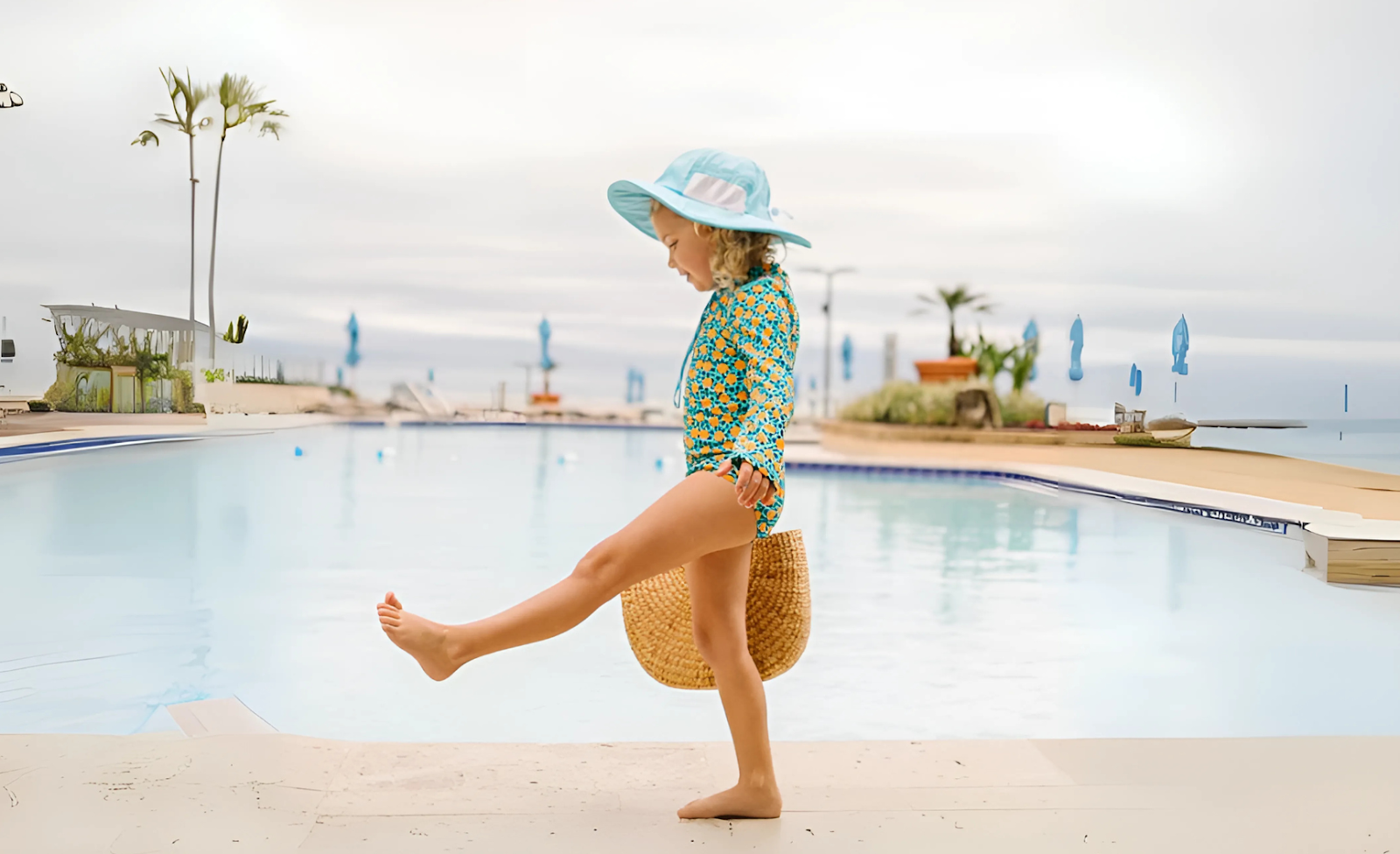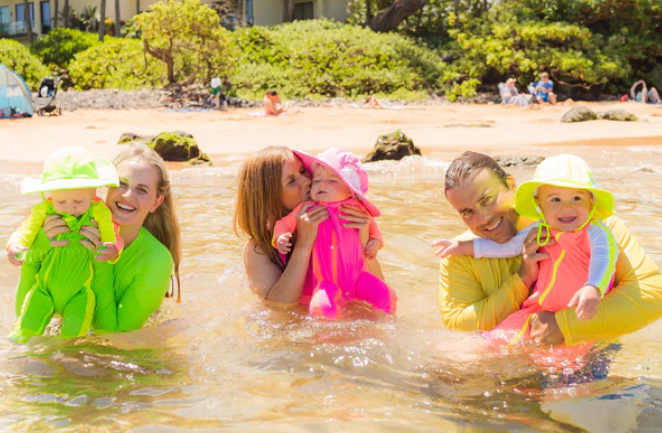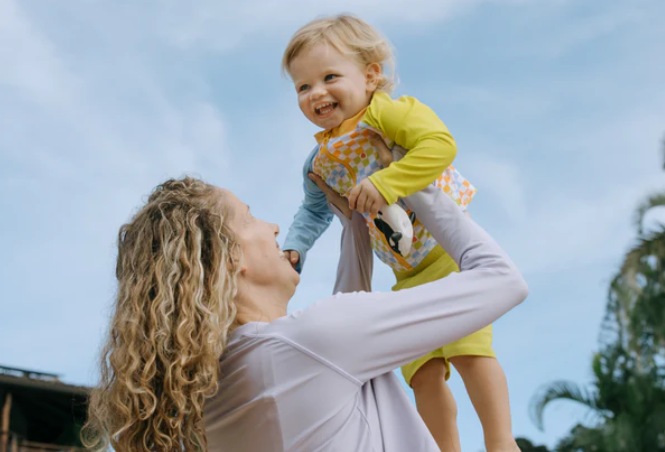
10 summer safety tips for parents on vacation with kids
Summer vacations are often some of our children’s most cherished memories. But while the kids are having fun, you’ll need to balance relaxation with responsibility. From preventing heat stroke to avoiding drowning accidents, parents must navigate the risks without stifling the fun.
Fortunately, enjoying your vacation and keeping your kids safe is something you can accomplish with smart planning and the right gear. Discover how to keep your kids safe during summer vacations with these 10 summer safety tips for parents.
Tip 1: Choose UPF 50+ sun-protective swimwear
Regular swimsuits are cute, but they're not doing much to protect your child's skin from harmful UV rays. Wet fabric stretches and lets even more UV radiation through to your kid's delicate skin. You need sun-protective swimwear.
UPF 50+ swimwear blocks 98% of those nasty UVA and UVB rays, giving your child consistent protection that won't wash off during water sports or swim time. Look for full coverage designs with front zippers (they make getting dressed so much easier), and fabrics that stay protective even when stretched or soaked.
Our kids' sun-protective swimwear is made from lightweight, breathable fabrics that keep children comfortable during all their physical activity. For maximum coverage during summer camp programs or other all-day events, try long-sleeve rash guards or full sunsuits that protect their torsos and arms.
Tip 2: Apply broad-spectrum sunscreen
Even with protective clothing, you still need broad-spectrum, water-resistant sunscreen for exposed skin. Apply it 15 to 30 minutes before your kids head outside, and choose SPF 30 or higher for lasting protection.
Parents often miss:
- Tops of feet.
- Ears and behind ears.
- Along the hairline.
- That little strip of neck that peeks out of shirts.
- Back of hands and wrists.
- Eyelids and around eyes.
- Lips and corners of mouth.
Make sunscreen application part of your morning routine, and your child won't come home looking like a lobster.
Reapply every two hours, and immediately after swimming or if your kid has been sweating. A full day of summer fun typically requires 4–5 sunscreen applications.
Tip 3: Practice water safety
Any body of water, from backyard pools to splash pads, requires your attention. With young children and weak swimmers, practice "touch supervision" by staying close enough to reach them.
During group activities at summer camps or community centers, make sure there's always a designated "water watcher," a responsible adult who watches the kids in the water. Even kids who swim like fish need supervision.
Tip 4: Use neon swimwear for better visibility
High-visibility swimwear makes your child easy to spot in any type of water. Neon colors cut through crowded pools, murky lake water, and busy beaches. These eye-popping colors work in most conditions, from blazing sunshine to cloudy days.
SwimZip offers neon tankinis and high-visibility swimwear for boys and girls in proven safety colors. Girls' sun-protective bikinis and boys' sun-protective swimwear combine maximum visibility with UPF 50+ protection. Most children love bold colors, so you get extra points for making safety cool.
Tip 5: Prevent heat-related illness
Kids overheat faster than adults. Their little bodies can't regulate temperature as efficiently. During water activities and beach time, heat exhaustion and heat stroke can sneak up quickly.
Create shaded rest areas to give kids breaks from direct sunlight. Lightweight, loose clothing helps kids stay cool during physical activity.
Heat exhaustion and heat stroke make your child:
- Unusually tired or weak.
- Flushed and red-faced.
- Breathe rapidly.
- Sweat excessively or have hot, dry skin.
- Experience headaches and dizziness.
- Feel nauseous, confused, or have muscle cramps.
If you notice any of these signs, act immediately. Learn the differences between heat rash and sun poisoning to identify what your child is experiencing.
Check out these sun protection tips for more winning strategies.
Tip 6: Protect eyes and faces with accessories
Your child's face and eyes are vulnerable to UV damage, so don't skimp on protective accessories. Wide-brimmed sun hats with UPF 50+ protection shield their face, ears, and neck while keeping them cool during outdoor activities.
Polarized sunglasses with UV protection make a huge difference. Look for impact-resistant lenses and flexible frames that can keep up with active kids during summer programs and water sports.
Don't forget lip protection with SPF, and make sun safety fun with stylish girls' sun hats that complement their swimwear. When kids feel good about how they look, they're more likely to keep their protective gear on.
Tip 7: Stay hydrated
Kids need plenty of water throughout the day, not just when they say they're thirsty. Their bodies lose fluids quickly, and dehydration can happen fast, even if they’re playing in water. Adults need 8–10 glasses during sun exposure; children need even more.
Pack multiple water bottles, and skip the sugary drinks that accelerate dehydration. Build hydration into activity routines with scheduled water breaks during summer programs and outdoor activities.
Tip 8: Plan activities to avoid peak sun intensity
The sun is most dangerous between 10 AM and 4 PM. That's when UV rays are strongest and most likely to damage your child's sensitive skin. Smart scheduling prevents sunburn and heat-related illness.
Plan outdoor activities, water sports, and field trips for early morning or late afternoon when the sun is less intense. If kids must be outside during peak hours, make sure they have access to shaded areas, like pavilions, trees, or covered structures.
Check the UV index to know what level of protection your family needs. Higher readings mean you need to be extra careful.
Tip 9: Secure pools and water areas at home
Home pool safety is all about preventing unsupervised access. Install a four-sided fence at least four feet high with gates that close and latch automatically. Use safety covers that can support weight when the pool isn't being used.
Door alarms on pool area entrances and motion-sensor pool alarms add extra protection. Store pool toys and flotation devices away from the water. They can attract curious children when no adults are around.
Keep sightlines to the pool clear from your house and maintain all safety features. Teach your children the pool rules and that adult supervision is always required, even for quick backyard activities.
Tip 10: Pack a summer safety kit
A safety kit should include broad-spectrum sunscreen, plenty of water, a first-aid kit with bandages and antiseptic wipes, and extra protective clothing.
Include emergency contact information and any necessary medications. For day camps and field trips, add insect repellent, snacks that won't spoil in heat, and backup sun protection items, like extra sun hats or sunglasses.
Keep your kit stocked and easily accessible in your car, beach bag, or wherever your family's summer activities take you. When everything's organized and ready to go, you can focus on making memories instead of scrambling for supplies.
Keep your family protected with SwimZip
SwimZip makes summer safety simple. Our collection of UPF 50+ swimwear combines sun protection with styles your family will want to wear. Our swimwear carries the Skin Cancer Foundation's Seal of Recommendation, so you know you’re getting maximum sun protection.
From baby sun-protective swimwear for your littlest splashers to boys' sun-protective options for your active older kids, we protect the whole family. If you want everyone to look coordinated and stay protected, shop our matching family swimwear. Finish out your look with swimwear accessories that look great and provide safe summer fun.
Summer care for kids FAQ
Should my child wear sunscreen every day?
You should apply sunscreen to your kids every day they will play outside, and more frequently during the summer months. Even on cloudy days, up to 80% of UV rays reach our skin.
Apply sunscreen every morning as part of their routine. For extended outdoor fun activities or water sports, reapply every two hours. Sun-protective clothing offers even better protection than sunscreen, so combine both for maximum summer defense.
What drinks are good for heat exhaustion?
Water is the best way to prevent and treat heat exhaustion. Skip the sports drinks unless your child has been sweating heavily for over an hour. Coconut water is also good because it naturally replaces electrolytes without added sugars. Avoid sodas, fruit juices, and caffeinated drinks that can make dehydration worse. If heat exhaustion symptoms appear, give small sips of cool water every few minutes. Don't let your child chug large amounts of water at once, as this can cause nausea and make them feel worse.
At what age should kids go on vacation?
Your kids can travel at any age with proper planning. Infants actually travel more easily than toddlers since they sleep more and can't run. Match your destination to your child's activity levels and attention span. Beach vacations are great for all ages, while theme parks suit kids who can walk long distances.
What type of clothing will keep you cool in the heat?
Lightweight, loose-fitting clothes in light colors keep kids cool during outdoor activities. Breathable fabrics, like cotton and other moisture-wicking materials, help sweat evaporate quickly. Sun-protective clothing with UPF ratings provides cooling shade while blocking harmful rays.
Avoid tight-fitting clothes that trap heat against the skin. Long sleeves might seem counterintuitive, but they actually keep kids cooler than exposed skin in direct sunlight. Dark colors absorb more heat, so stick with whites, pastels, and light blues.
Can sunscreen block vitamin D?
Sunscreen can reduce vitamin D production, but skin cancer risk outweighs this concern during peak summer months. Your child can still get adequate vitamin D through brief sun exposure on arms and legs before applying sunscreen, plus dietary sources, like fortified milk and fatty fish.
Most pediatricians recommend vitamin D supplements, especially during winter months. Protect your child's skin during extended outdoor activities and water sports, but don't stress about every minute of sun exposure during daily activities around your neighborhood.
Further reading
Are black swimsuits safe for swimming?
What to do if you get sun poisoning
Choose the best swimwear accessories by SwimZip



Leave a comment
This site is protected by hCaptcha and the hCaptcha Privacy Policy and Terms of Service apply.